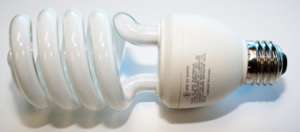Lighting
By Susan Bloom
Over the past decade, most consumers have become familiar with the benefits of compact fluorescent lamps (CFLs) and the fact that this technology—which consumes 75% less energy than incandescent bulbs while lasting up to 10 times longer—is a popular, energy-efficient and cost-effective replacement for the nation’s soon-to-be-phased-out base of incandescent bulbs.

CFLs contain mercury and must be properly recycled. Image courtesy of ENERGY STAR.
What many consumers may not know, however, is that due to the small amount of mercury contained within the glass bulb—necessary for the lamp to operate—CFLs cannot simply be thrown away when they reach end-of-life, but rather must be recycled or otherwise properly disposed in accordance with local jurisdictions.
By recycling CFLs, we can help prevent the release of mercury into the ground, water and atmosphere; enable glass, metal and other materials in the bulbs to be reused; and ensure compliance with the environmental regulations in many towns, cities and states.
Since 2003, in an effort to promote the proper recycling of CFLs and assist consumers in undertaking this critical activity, a number of CFL manufacturers joined forces through the National Electrical Manufacturers Association (NEMA) to establish http://www.lamprecycle.org, a clearinghouse for information related to CFL recycling.
Currently supported by nearly 20 lamp manufacturers, the organization provides information on the importance of this activity, current recycling regulations by state, and locations where customers can go for help in recycling their CFLs.
There are currently several easy ways to recycle burned-out CFLs:
- Through a participating retailer: Most areas of the U.S. are covered by participating retailers that offer free and convenient recycling services. These include The Home Depot’s more than 2,000 locations in the U.S. and Canada, where customers “can simply bring in any expired, unbroken CFL bulbs, place them in a plastic bag, and deposit them into a specially marked CFL collection unit. The bulbs will then be managed responsibly by an environmental management company who will coordinate CFL packaging, transportation, and recycling to maximize safety and ensure environmental compliance.” Other retailers that offer free CFL recycling services include IKEA furniture stores, Orchard Supply Hardware, and regional outlets such as Ace Hardware, TrueValue Hardware and Menards.
- Through mail-back services: A variety of CFL manufacturers and specialty recycling companies provide pre-labeled recycling kits that enable customers to recycle CFLs through the mail for a fee (which typically includes the cost of shipping to the recycling center).
- Through local waste collection agencies: Consumers can bring CFLs to their town’s designated disposal site for recycling. Some towns may also collect such items curbside on a regular basis, while others may designate 1-2 days per year for the collection of such items. All of these services may be free or may incur a small fee, depending on the town.
In all cases, consumers are advised to store CFLs in sturdy packaging or in their original boxes to minimize the chances of breakage. The bottom line? CFL recycling is easier than ever and is the right thing to do for the environment.
For more information on CFL recycling guidelines, retail partners nationwide, a list of companies who provide recycling services and recycling regulations by state, visit the EPA’s site at www.epa.gov/cfl/cflrecycling.html, trade association NEMA at www.nema.org, or www.lamprecycle.org.
Compact Fluorescent Lights: What You Need To Know
- Compact fluorescent lamps contain mercury and should be recycled
- Retailers such as Home Depot and IKEA offer lamp recycling
- Some manufacturers offer mail-back service
- Some towns accept CFLs for recycling at designated disposal sites